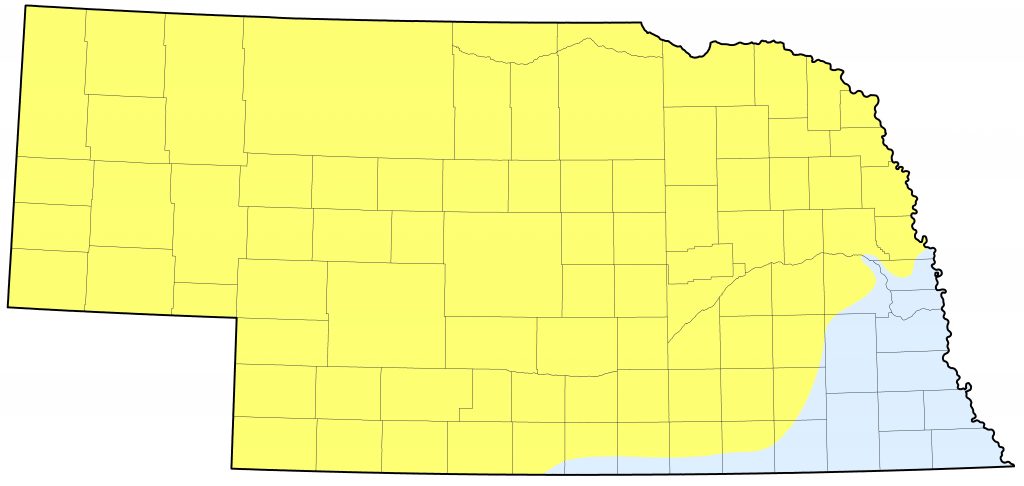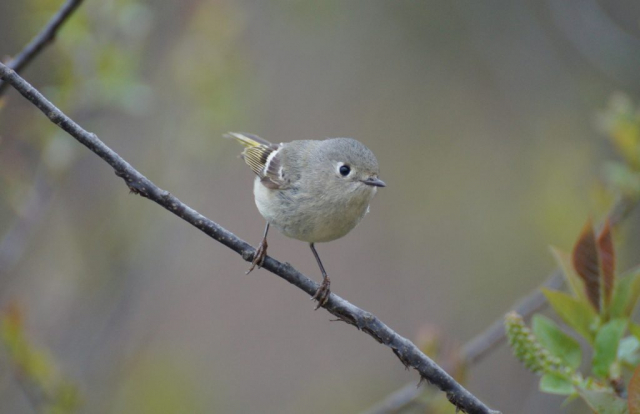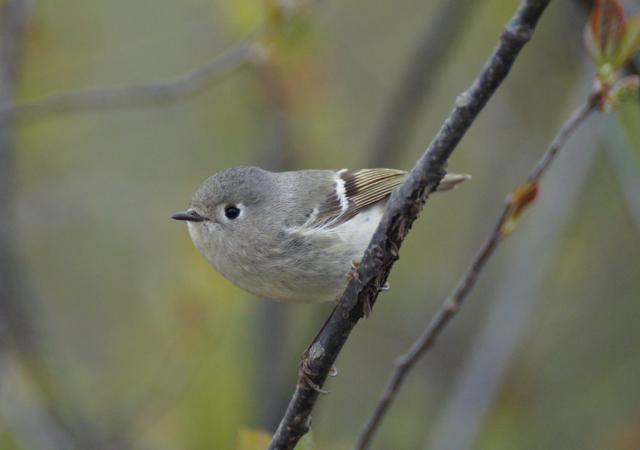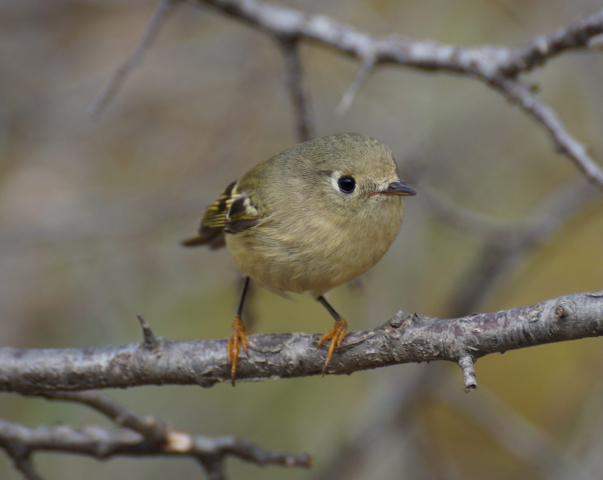Corthylio calendula calendula
Status: Common regular spring and fall migrant east and central, uncommon west. Rare regular winter visitor south and southeast, rare casual elsewhere.

Documentation: Specimen: UNSM ZM6713, 13 Apr 1901 Lancaster Co.
Taxonomy: Ruby-crowned Kinglet taxon calendula of the New World was split as genus Corthylio from remaining New and Old World species in genus Regulus based on differences in morphology, genetics, and vocalizations (Chesser et al 2021).
Three subspecies are recognized (AviList 2025), one (obscurus) extinct; the others are calendula, which breeds from northwest Alaska east across Canada to Nova Scotia and the northern tier of coterminous United States, including south through the Sierra Nevada to mountains of southern California and through Rocky Mountains south to central Arizona and central New Mexico, and grinnelli, largely sedentary from coastal regions of southern Alaska to southern British Columbia, including Vancouver Island and other islands.
Nebraska migrants are presumed calendula.
Spring: Mar 7, 9, 10 <<<>>> May 27, 27, 28 (south and east), Mar 23, 25, 27 <<<>>> May 26, 26, 27 (north and west)
Later dates in the north and west are 29 May 2025 Sioux Co, 1-18 Jun 1992 Dawes Co in a “patch of simulated boreal forest” (Grzybowski 1992) and 22 Jun 2022, singing vigorously in pines in Carter Canyon, Scotts Bluff Co.
Arrival is mid- to late Mar and departure is in May. A report by Aughey, 5 Jun 1865 Dakota Co, is doubtful (Sharpe 1993) although possibly a late migrant.
- High counts: 47 at Fontenelle Forest, Sarpy Co 11 Apr 1999, 35 in southeast Otoe Co 25 Apr 1999, and 30 at Pawnee Lake, Lancaster Co 19 Apr 2009.
Fall: Aug 31, Sep 1, 1 <<<>>> Oct 22, 22, 24 (north and west); Sep 3, 3, 5 <<<>>> winter (south and east)
Earlier dates in the north and west are 25 July 1979 Lincoln Co, 26 Jul 2004 Wind Springs Ranch, Sioux Co, and 7-16 Aug 1977 McPherson Co.
Earlier dates in the south and east are 29 Jul 1920 Lancaster Co (specimen, UNSM ZM6708), 5 Aug 2016 Fontenelle Forest, 20 Aug 1988 Lancaster Co, 21 Aug 1934 Webster Co (Ludlow 1935), and 21 Aug 2011 Dodge Co.
Later dates in the north and west are 31 Oct 2023 Scotts Bluff Co, 2 Nov 2024 Gotte Park, Kimball Co, 2 Nov 2024 Golf Course, Kimball Co, 28 Oct-2 Nov 2024 Smith Lake WMA, Sheridan Co, 5 Nov 2021 Antelope Co, and 6 Nov 2011 Brown Co.
The Jul-Aug dates may be of early migrants from the nearest breeding locations, the Black Hills of South Dakota, where the species is an uncommon breeder (Tallman et al 2002), and the Laramie Mountains in southeastern Wyoming (Faulkner 2010). Migrants generally arrive in mid-Sep. Early dates in the north are earlier than those in the south, indicating a protracted fall passage through the state.
Departure dates are obscured by birds lingering into Dec, especially in the south (see Winter). Departure from the north and west occurs by mid-Oct.
- High counts: 51 in Douglas and Washington Cos 2 Oct 1999, 50+ at Branched Oak Lake, Lancaster Co 3 Oct 1999, 50 at Platte River SP, Cass Co 18 Sep 2010, and 50 in Cedar Co 15 Oct 2018.
Winter: Ruby-crowned Kinglets depart gradually in fall, with several lingering Dec reports westward in the Platte River Valley and the northeast, but few remain in those areas after Dec. In the Platte and North Platte River Valleys there are several Jan-Feb reports west to the Lake McConaughy, Keith Co area, westernmost at Ash Hollow SHP, Garden Co 22 Feb 2020, and north to Burt Co in the east, with an outlier in Dakota Co 1 Jan 2000. In the Republican drainage one was at Rock Creek Lake SRA, Dundy Co, 29 Dec 2004.
The only Nebraska reports in the north and west Dec-Feb are 11-14 Dec 2022 Scotts Bluff Co, a “first winter record” in Dawes Co 16 Jan-17 Feb 1983 (Williams 1983), 15 Jan 2014 Garden Co, 21 Jan 1988 Dawes Co, 14 Feb 1972 Brown Co, and 22 Feb 2020 Ash Hollow SHP, Garden Co.
Images
Abbreviations
SHP: State Historical Park
SP: State Park
SRA: State Recreation Area
UNSM: University of Nebraska State Museum
Literature Cited
AviList Core Team, 2025. AviList: The Global Avian Checklist, v2025. https://doi.org/10.2173/avilist.v2025.
Chesser, R.T., S.M. Billerman, K.J. Burns, C. Cicero, J.L. Dunn, B.E. Hernández-Baños, A.W. Kratter, I.J.Lovette, N.A. Mason, P.C. Rasmussen, J.V. Remsen, Jr., D.F. Stotz, and K. Winker. 2021. Sixty-second Supplement to the American Ornithological Society’s Check-list of North American Birds. Ornithology 138, Issue 3, https://doi.org/10.1093/ornithology/ukab037.
Faulkner, D.W. 2010. Birds of Wyoming. Roberts and Company, Greenwood Village, Colorado, USA.
Grzybowski, J.A. 1992. Southern Great Plains Region. American Birds 46: 1151-1152.
Ludlow, C.S. 1935. A quarter-century of bird migration records at Red Cloud, Nebraska. NBR 3: 3-25.
Sharpe, R.S. 1993. Samuel Aughey’s list of Nebraska birds (1878): a critical evaluation. NBR 61: 3-10.
Tallman, D.A., Swanson, D.L., and J.S. Palmer. 2002. Birds of South Dakota. Midstates/Quality Quick Print, Aberdeen, South Dakota, USA.
Williams, F. 1983. Southern Great Plains Region. American Birds 37: 314-317.
Recommended Citation
Silcock, W.R., and J.G. Jorgensen. 2025. Ruby-crowned Kinglet (Corthylio calendula). In Birds of Nebraska — Online. www.BirdsofNebraska.org
Birds of Nebraska – Online
Updated 19 Jul 2025



